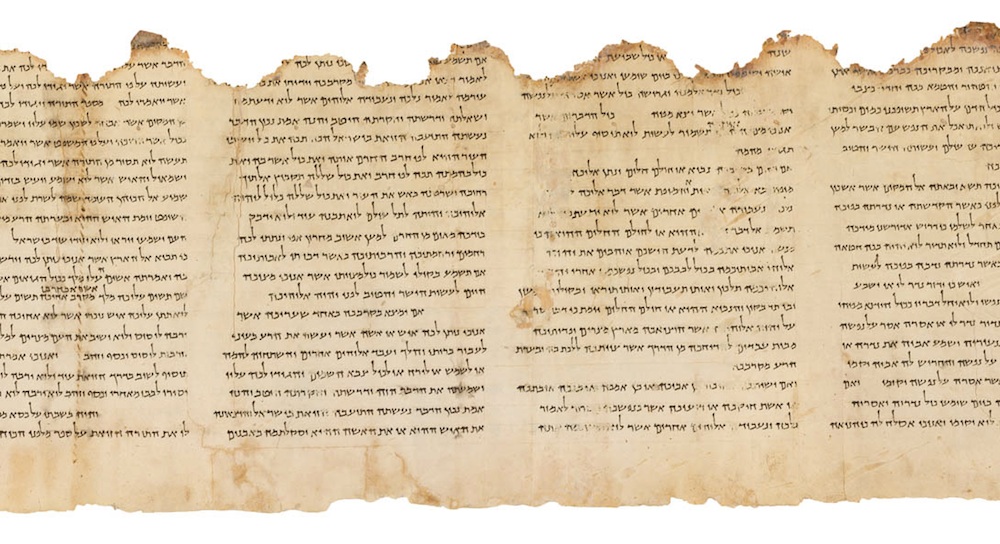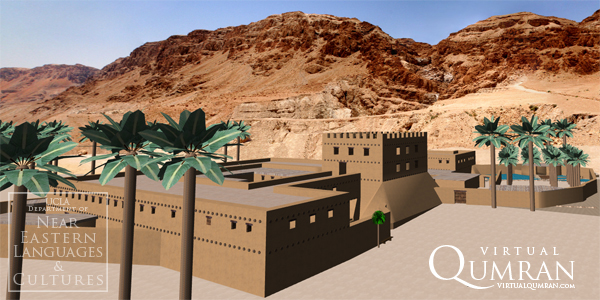What are the Dead Sea Scrolls, the ancient texts from the Hebrew Bible found in the caves of Qumran?
The Dead Sea Scrolls include many ancient texts from the Hebrew Bible, as well as psalms and other works.

The site of Khirbet Qumran (a modern Arabic name) is located in the West Bank, near the northern edge of the Dead Sea, and is where the Dead Sea Scrolls were found in 11 nearby caves nearly 80 years ago. Though it has been decades since any scrolls were discovered, researchers announced in February 2017 that they had found a 12th cave near Qumran.
The first settlement was created during the Iron Age, but was abandoned about 2,600 years ago, long before the scrolls were made.
Archaeological work indicates that a second settlement existed between roughly 100 B.C. and A.D. 68, when it was captured by the Roman army and destroyed in a fire. The heat was so intense that modern-day archaeologists have found glass vessels "melted down" by it. It is in this settlement that many scholars believe at least some of the Dead Sea Scrolls were written before being hidden away.
How and when were the Dead Sea Scrolls found?
Explorers first came across Qumran in the 19th century, and the site took on new importance with the discovery of the Dead Sea Scrolls.
The scrolls were first found in 1946 or 1947 (accounts of the exact date vary) when a young shepherd named Muhammed Edh-Dhib was looking for a stray goat. At one point "he was amusing himself by throwing stones. One of these fell into a small hole in the rock and was followed by the sound of the breaking of pottery," writes British researcher Geza Vermes in his book "The Story of the Scrolls: The Miraculous Discovery and True Significance of the Dead Sea Scrolls" (Penguin Books, 2010). "Muhammed climbed in and found several ancient manuscripts in a jar. Altogether seven scrolls were subsequently removed from the cave."
In 1949, a joint expedition excavated the cave Muhammed found, called cave no. 1. Over the next decade, local Bedouin and scientific researchers would discover the remains of more than 900 manuscripts in 11 caves. Each cave is located near Qumran, the farthest one being just over 1 mile (1.6 kilometers) to the north of the site. The newly discovered 12th cave contained a blank scroll along with the remains of jars, cloth and a leather strap. The researchers said they believe these items were used to bind, wrap and hold the scrolls.
Recent analysis of textiles found with the scrolls shows that the textiles were originally used as clothing. They are all made of linen (even though wool was the more popular garment at the time), with most of them undecorated. The researchers argue that according to historical accounts these textiles are similar to those worn by people belonging to an ancient sect called the Essenes.
What's written in the Dead Sea Scrolls?
The scrolls found include copies of Genesis, Exodus, Isaiah, Kings and Deuteronomy, among other canonical works from the Hebrew Bible. They also include calendars, hymns, psalms, apocryphal (non-canonical) biblical works and community rules. One scroll is made of copper and describes the location of buried treasure. There were no New Testament gospels found in the caves.
How old are the Dead Sea Scrolls?
Study of the letter styles of the scrolls, along with carbon-14 dating, indicates that they were penned between roughly 200 B.C. and A.D. 70, the copper scroll being written perhaps a few decades later. Vermes writes that the vast majority of the scrolls are written in Hebrew with a smaller number in Aramaic and only a few in Greek (although Greek was a popular language at the time). Most of the scrolls were composed on leather (sheep and goat skin in particular).
What was Qumran used for?
The settlement of Qumran is very small and never grew much larger than 1 acre (0.4 hectare). Its population may have been no higher than a few dozen people.
Recent archaeological work by Yitzhak Magen and Yuval Peleg of the Israel Antiquities Authority indicates that around 100 B.C. a Hasmonean military outpost with a watchtower and stables was constructed at Qumran. The Hasmoneans were a dynasty of Jewish rulers that controlled a state centered in modern-day Israel.
In an interview with the website Heritage Key, Peleg stressed that this outpost was a modest structure. "It's a small site with small units. All its purpose was to see that no enemy army was coming to the Dead Sea shores, climbing the cliffs towards Jerusalem."
In 63 B.C., the Romans took control of the Hasmonean Kingdom, and archaeological work indicates that Qumran transitioned to civilian use. Magen and Peleg wrote that around this time the site's water supply was "tripled" with the construction of an aqueduct and additional pools. Altogether, Qumran had eight stepped pools that some researchers believe to be ritual baths known as "mikveh."
Why the water supply was increased is a matter of debate. A priest named Roland de Vaux, who excavated at Qumran decades ago and first noted the stepped water pools, argued that the site's population was increasing and the water system expansion was needed for drinking and baths.
Magen and Peleg argue that this is unlikely. Their excavations show that residential space at Qumran did not increase and that only two or three of the stepped pools were ritually suited to be used as mikveh. The researchers argue that pottery production was the reason for Qumran's water system expansion. They point out that "tens of thousands of pottery fragments" were found at Qumran and their excavations reveal that at least one large pool had a thick layer of potter's clay.
The people at Qumran apparently engaged in writing. De Vaux's excavations revealed a room that he called the "scriptorium," which had two inkwells along with plastered benches or tables. It could have been used for writing scrolls and/or business records, depending on how the site is interpreted.
The Caves and Monastery of the Dead Sea Scrolls are now a World Heritage site recognized by UNESCO.
Who is buried at Qumran?
Qumran has three cemeteries, the main burial ground located just to the east of the site. It's estimated that 1,000 tombs are located in them, some dating to the time of Qumran but others (such as those made by local Bedouin) dating to much later.
Dating the burials at the cemetery is a difficult problem, wrote Brian Schultz, a professor of Biblical and Theological Studies at Fresno Pacific University, in a 2006 article in the journal "Dead Sea Discoveries." Researchers have to rely on artifacts found in the tombs, the orientation of the burials (the Jewish burials are more likely to face north-south) and radiocarbon dating.
So far, 46 tombs have been excavated and published, Schultz said, out of which 32 can be dated to the time of Qumran, most of them adult men. The complete lack of children and the presence of (at most) only five women suggest that a monastic group composed mainly of men lived at Qumran, he noted.
Why are the Dead Sea Scrolls in Qumran?
The relationship between the scrolls and Qumran is a source of great scholarly debate. Some researchers, such as de Vaux, have argued that the scrolls were deposited in the caves by the Essenes, who in turn lived at Qumran. On the other hand, some scholars, such as Magen and Peleg, argue that the site itself has no relationship to the scrolls, and that the manuscripts were deposited by refugees, likely from Jerusalem, fleeing the Roman army.
Robert Cargill, an associate professor of biblical studies at the University of Iowa, has created a virtual model of Qumran, giving researchers a tool to help reconstruct its architecture.
He argues that multiple groups (including people from Qumran) could have been putting scrolls into the caves. This theory helps explain why the caves held scrolls written in three languages and why the copper scroll (discussing treasure) may date to after Qumran's destruction.
Who wrote the Dead Sea Scrolls?
Researchers are now using artificial intelligence (AI) to study the Dead Sea Scrolls. In one case, a study using AI and statistics found that a Dead Sea Scroll manuscript was written by not one, but two scribes. This analysis looked at subtle differences in the handwriting on the Great Isaiah Scroll, one of the seven scrolls originally found by the Bedouin shepherd, according to a 2021 study in the journal PLOS One.
Another AI analysis, this time looking at handwriting and radiocarbon dates, found that some of the Dead Sea Scrolls were older than previously thought. Using an AI program called Enoch, researchers analyzed the handwriting on some of the scrolls. Then, they obtained new radiocarbon dates of 27 scrolls — a feat that required cleaning the scrolls first, as many had been previously exposed to castor oil in an attempt to better read their texts. However, castor oil can interfere with radiocarbon dating.
By giving AI the handwriting samples matched with the new radiocarbon dates, the researchers were able to use Enoch to analyze handwriting on other scrolls and date them, they reported in a 2025 study in the journal PLOS One.
However, scholars cautioned that AI should be only one of many techniques used to study the Dead Sea Scrolls. "After all, human handwriting, and all of its variations and idiosyncratic features, is a deeply human thing," Christopher Rollston, a professor and chair of biblical and Near Eastern languages and civilizations at The George Washington University who was not involved with the research, previously told Live Science in an email. "Machines can be helpful in isolating features of a script, but the presence of a gifted palaeographer is at least as valuable as a machine-learning tool."
Editor's note: This article was originally published on Feb. 8, 2017 and was updated on June 13, 2025 to note new insights about the Dead Sea Scrolls gleaned from artificial intelligence research.
Get the world’s most fascinating discoveries delivered straight to your inbox.

Owen Jarus is a regular contributor to Live Science who writes about archaeology and humans' past. He has also written for The Independent (UK), The Canadian Press (CP) and The Associated Press (AP), among others. Owen has a bachelor of arts degree from the University of Toronto and a journalism degree from Ryerson University.
You must confirm your public display name before commenting
Please logout and then login again, you will then be prompted to enter your display name.




